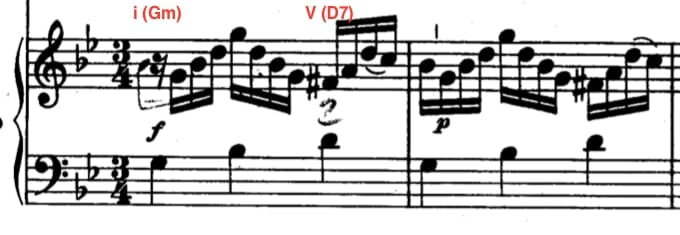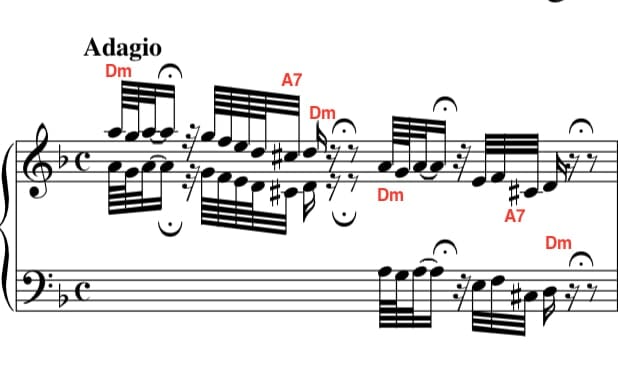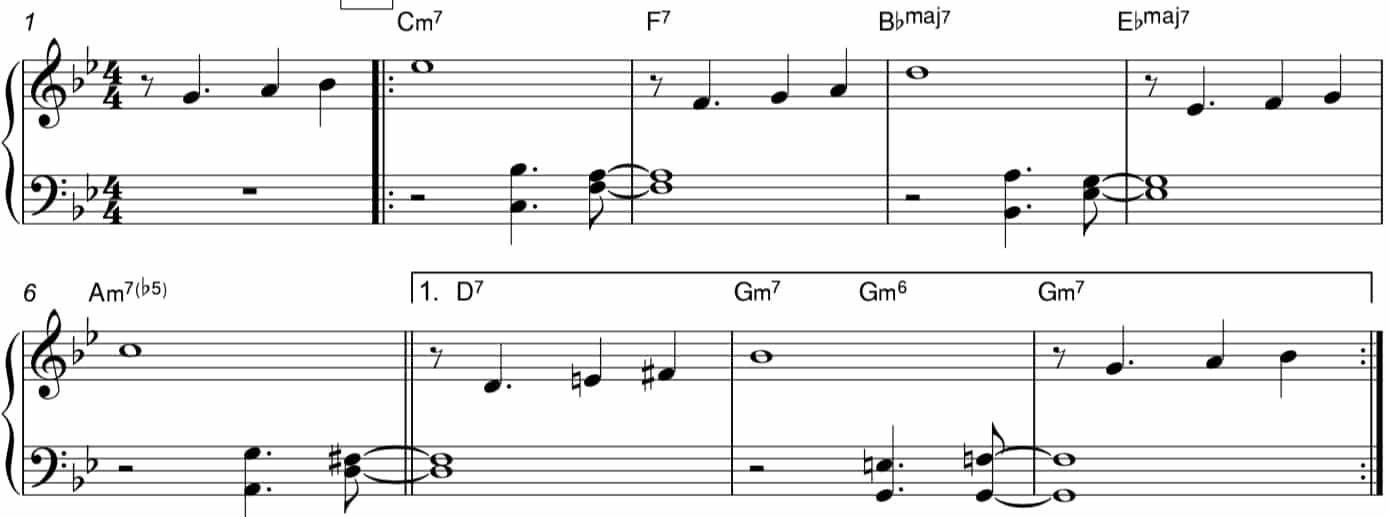Minor Key Piano Music: The Ultimate Guide
 Would you like to master how to play minor key piano music?
Would you like to master how to play minor key piano music?
You’ve come to the right place.
In this lesson, you’re going to gain solid foundation for playing piano in minor keys.
Let’s get started.
One Thing You Need To Understand Before Dealing With Minor Key Piano Music
 Before you start dealing with minor key piano music, learn about major scales first.
Before you start dealing with minor key piano music, learn about major scales first.
This is because major scales serve as reference points for everything we talk about in music.
You’ll learn minor key piano music when you contrast it with major scales.
Let’s go into more detail.
Why Mastering Minor Key Piano Music Starts With The Scales
 Scales are fundamentally a sequence of notes used for creating musical elements such as melody and rhythm.
Scales are fundamentally a sequence of notes used for creating musical elements such as melody and rhythm.
A scale starts with a note called a root and ends just before playing the same note a register higher.
The minor scale is derived from the major scale.
For instance, we can pick up an A minor scale from a C major scale.
The C major scale has C-D-E-F-G-A-B as its set of notes.
We simply start the same C major scale on A rather than C to get an A minor scale i.e. A-B-C-D-E-F-G.
While we still have all the same notes, the mere fact that we start on and emphasize A gives us a different sounding scale.
 Since A minor and C have the same set of notes, both scales are relative to each other. We can then say that A minor is the relative minor scale of C major.
Since A minor and C have the same set of notes, both scales are relative to each other. We can then say that A minor is the relative minor scale of C major.
This is also the reason why this scale is called A natural minor scale. It’s called natural minor because it is a minor scale that exists naturally inside a major scale.
While the natural minor scale has a nice sound and all, it doesn’t really work well all the time.
You’ll see this when we look at chord progressions we form from the minor scale.
Why You Need Another Kind Of Minor Scale
From a natural A minor scale, we can have a very basic 1-5 chord progression.
The 1-5 chord progression in the A natural minor scale is simply Am-Em.
Try playing this simple version:

In major keys, the 5 chord is a dominant 7th chord. It has a major triad built into it.
However, in minor keys, the 5 chord is also a minor chord. Now, while it sounds okay, it doesn’t sound very convincing or powerful at all.
What you want is a chord that resolves really nice into the 1 minor chord.
Now try this Am-E7-Am chord progression:

Doesn’t that sound more satisfying?
To make this possible, composers from centuries of old developed the harmonic minor scale.
The harmonic minor scale looks like this:

If you take a closer look, the E7 chord occurs naturally in the A harmonic minor scale.
Take a look at the A harmonic minor scale. You’ll see each of the notes of E7 existing naturally in it:

Now let’s take a look at some common chord progressions that use this concept.
4 Minor Key Piano Music Chord Progressions You Need To Learn
 Obviously, the key to playing minor key piano music is having the ability to play minor key chord progressions.
Obviously, the key to playing minor key piano music is having the ability to play minor key chord progressions.
Let’s look at some of the most common:
1. The i-V Progression
Without a doubt, the i-V chord progression is the foundational chord progression. You can easily find this chord progression in a lot of classical music.
One of the most famous examples of this can be seen and heard in Bagatelle in A minor a.k.a. “Fur Elise” by Ludwig Van Beethoven:

As you can see and hear, the piece simply goes Am-E7-Am over the first 4 bars.
Another example is Johann Sebastian Bach’s Sonata in G minor BWV 1020 that goes Gm – D7 for the 1st 2 bars:

You can also see the use of the harmonic minor scale to build the melody.
For instance, J.S. Bach’s Toccata and Fugue in D minor, has this exact idea going. Check it out below:

In both examples, the harmonic minor scale is used to come up with those chords.
Let’s investigate another minor key chord progression
2. The Minor 1-6-3-7 (i-bVI-bIII-bVII) Progression
If you’ve heard the song, “Wonderwall”, by Oasis, you certainly have heard of this minor key chord progression.
In the original recording, the chords go F#m – D – A – E.
Here’s a simple “sing-along” arrangement of the chords for piano:

Another tune that uses the minor 1-6-3-7 chord progression is “Little Do You Know” as popularized by Alex & Sierra.
The chords go Am – F – C – G:

This chord progression, if you look at it carefully, is the a major chord progression that just goes 6 – 4 – 1 – 5.
It’s a variation of the 1 – 5 – 6 – 4, probably the most famous chord progression in pop music for so many decades.
Now let’s look at another minor chord progression.
3. The ii(b5)-V-i Progression
In jazz, the ii(b5)-V-i is the essential minor chord progression.
Here’s what it looks like in the key of Am:

Since we’re now talking about jazz, a great example of where it’s used is Autumn Leaves.

In fact, almost 99% of jazz tunes in a minor key use this chord progression
Interestingly, learning how to play Autumn Leaves in all 12 keys helps you build the skills to deal with both major and minor 2-5-1 chord progressions.
Learn this chord progression in all 12 keys.
4. The Minor Line Cliche
Lastly, one of most famous minor key chord progressions is the minor line cliche.
Some of the best examples include Led Zeppelin’s “Stairway To Heaven” and the jazz standard “My Funny Valentine.
Here’s an example of a minor line cliche like you would find in “Stairway to Heaven”:

Practice playing this minor line cliche in all 12 keys to get it under your fingers.
Going forward, let’s talk about the melodic side of minor key piano music.
7 Kinds Of Minor Scales You Need To Learn
 Since music has been played, minor scales have been thought of as serious, sad, somber, dark, or deep.
Since music has been played, minor scales have been thought of as serious, sad, somber, dark, or deep.
A lot of it has to do with the sets of notes used for melodies. Let’s talk about some of those.
First, let’s look at three traditional minor scales:
- Natural minor scale –

- Harmonic minor scale –

- Melodic minor scale –

From a common practice period music perspective (i.e. classical, etc.), these 3 scales can be used interchangeably in minor key piano music.
Interestingly, in more contemporary styles, here are minor scales that sound great over minor key piano music:
- Minor pentatonic scale –

- Minor blues scale –

Another interesting scale that adds an exotic flavor to music is the Phrygian scale:

The Phrygian scale can be used to add a kind of flamenco-like or Spanish sounding flavor to your solos.
Lastly, another important minor scale used in music nowadays is the Dorian scale:

Learn these scales in all 12 keys and use them to improvise music.
How To Practice Minor Key Piano Music Concepts
 Here are some key practice tips:
Here are some key practice tips:
- Practice chord progressions in a minor key.
- Study left hand comping techniques using minor chords.
- Practice targeting minor chord tones and improvise some melodies with them.
- Work on minor scales, practicing them with consistent fingering.
- Practice minoy key concepts in all 12 keys.
- Practice using minor scale notes as passing tones towards minor chord tones in improvisation.
- Use a jam track or metronome when working on minor key piano music concepts.
I hope that you enjoyed this lesson on minor key piano music.
If you have questions, comments, or suggestions for the next lesson, feel free to leave a note below.
Happy practicing.
